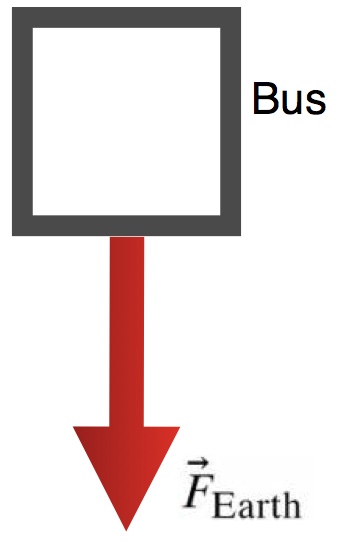Example: Finding the range of a projectile
In the previous example of time of flight, the out of control bus is forced to jump from a location $\langle 0,40,-5 \rangle$m with an initial velocity of $\langle 80,7,-5 \rangle m/s^{-1}$. We have now found the time of flight to be 3.65s and now want to find the position of where the bus returns to the ground.
Facts
- Starting position of the bus $\langle 0,40,-5 \rangle$
- Initial velocity of the bus $\langle 80,7,-5 \rangle$
- The acceleration due to gravity is 9.8 $\dfrac{m}{s^2}$ and is directed downward.
- The bus experiences one force - the gravitational force (directly down).
- The bus takes 3.65s to reach the ground (from previous problem)
Lacking
- The final position of the bus.
Approximations & Assumptions
- Assume no drag effects
- Assume ground is when position of bus is 0 in the y direction
Representations
Diagram of forces acting on bus once it leaves the road.
The general equation for calculating the final position of an object:
$$ \vec{r}_f = \vec{r}_i + \vec{v}_{avg} \Delta t $$
Also know as the position update formula.
Solution
From the previous problem you already know the final location of the ball in the y direction to be 0 as it has met the ground after 9.59s.
We now to find the range in the x and z directions in order to have a position vector for the final resting place of the bus.
There is no force acting in the x or z directions as the only force acting on the system is the gravitational force which acts in the y-direction.
This means that the initial velocities in both of these directions have remained unchanged.
We know the amount of time the bus has been traveling in the x-direction at its initial velocity and its initial position so we can compute the distance travelled in this direction using the position update formula for x-components.
$$ x_f = x_i + V_{avg,x} \Delta{t}$$
Plug in respective values for variables.
$$ = 0 + 80m/s(3.65s)$$
Compute range in x-direction.
$$ = 292m$$
Repeat same process for the z-components:
$$ z_f = z_i + V_{avg,z} \Delta{t}$$
Plug in respective values for variables.
$$ = -5 + -5m/s(3.65s)$$
Compute range in z-direction.
$$ = -23.25m$$
Write range(final position vector) using all components:
Final position = $$\langle 292,0,-23.255 \rangle m $$
